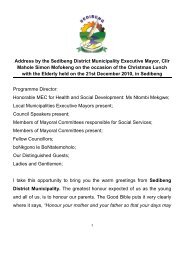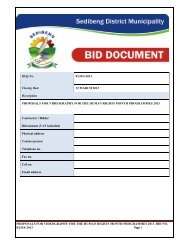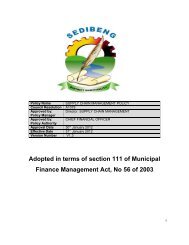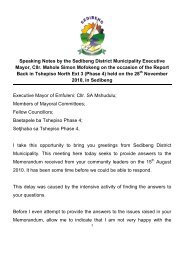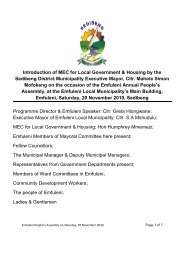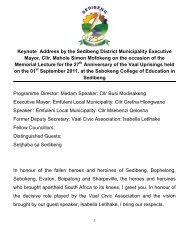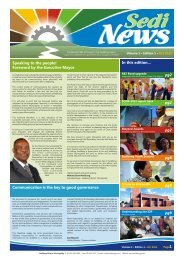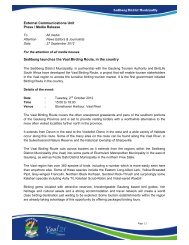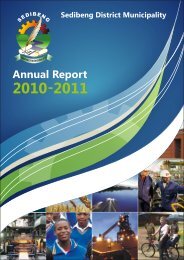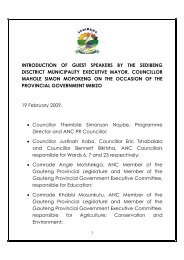Chapter 11 - Sedibeng District Municipality
Chapter 11 - Sedibeng District Municipality
Chapter 11 - Sedibeng District Municipality
Create successful ePaper yourself
Turn your PDF publications into a flip-book with our unique Google optimized e-Paper software.
• Pedestrian Safety: There is a lack of safe pedestrian and cycle w ays –<br />
especially along high volume, busy roads. The lack of pedestrian crossing<br />
facilities on freeways poses a threat to pedestrian safety as pedestrians cross<br />
busy roads under dangerous circumstances.<br />
12.2 Problem Statement<br />
The increased use of w alking and cycling, as alternative modes of non-motorised<br />
transport, and the sensitive application of facilities for these vulnerable road users,<br />
can make a significant difference to road safety and congestion levels. They also<br />
represent sustainable transport modes, w hich are beneficial to the environment.<br />
12.3 Strategy<br />
There is a direct link betw een the effective renewal of decaying urban areas and the<br />
provision of infrastructure for non-motorised transport. This aspect is included in the<br />
follow ing vision for the roll-out of non-motorised transport in <strong>Sedibeng</strong>.<br />
• Reduce the cost of urban transport for NMT users:This can be achieved<br />
by increasing the speed, user directness and safety of NMT traffic. This<br />
primarily requires proper access w alkw ays, extra NMT-only route links to<br />
avoid detours and separate w alkw ays and frequent crossings along all<br />
important MT roads.<br />
• Enable the safe use of bicycles for longer distance trips:The bicycle is an<br />
extremely attractive low -cost transport option w hen many trips are made<br />
annually. Traffic safety elements must be increased to enable and promote<br />
cycling as a transport mode. This must be supplemented by an efficient<br />
bicycle route netw ork and programmes targeting w omen and children.<br />
• Reduce the number of pedestrian casualties:Pedestrians are the most<br />
vulnerable road users w hen it comes to traffic accidents.<br />
• Integration of NMT and public transport:Widespread provision of secure<br />
end-of-trip facilities is required especially w hen an integration of NMT and<br />
public transport is required.<br />
• Promote NMT infrastructure:Safe pedestrian crossing facilities are essential<br />
on all roads, and the crossings must be frequently placed so that pedestrians<br />
do not jayw alk and form inappropriate desire lines. Separate pedestrian<br />
walkw ays that are inaccessible for motor vehicles are necessary.<br />
• Develop pedestrian malls in the CBD areas of SDM:Pedestrian malls are<br />
pow erful tools in urban renew al strategies and should be integrated w ith public<br />
transport facilities.<br />
• Promote and facilitate non-motorised travel in the area as a viable<br />
transport mode:This includes promoting w alking and cycling through<br />
initiatives such as Shova Kalula. This w ill include improving the security and<br />
attractiveness of walking and cycling and education and training w hile<br />
involving communities and schools.<br />
SDM DITP, 2008 to 2013 171 31 Aug 2010



